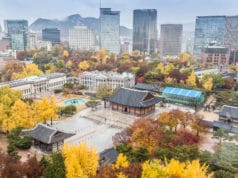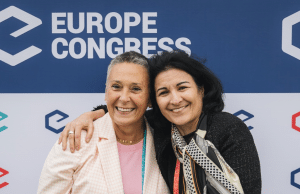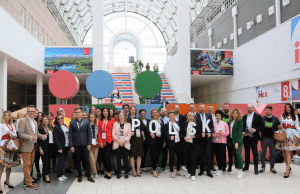From the rich history of tourism in Portorož I most remember the story of Benedictine monks who treated rheumatism symptoms with the sea mud from the nearby saltpans in the 13th century. The convent of Saint Lawrence stood in the location of today’s hotel Metropol. The Josephinian Reforms concluded the work of the monks in 1806. At the approximately same time a new tourist development of Portorož started happening.
The other story I recall is about the legendary Palace hotel. Its predecessor was apparently built in 1891 based on the design of English health resorts. This was the period of intense development of tourism and when the promenade, the public bath and the pier with restaurants were built. Portorož even had a seaplane station from 1897 and was officially declared a health resort. The prime of the city is linked with hotel Palace, which was built between 1908 and 1912. With Palace Portorož became a luxurious resort with the likes of Grado and Opatia. The hotel was top-notch for its time, it even hosted the first congresses and events in Portorož, especially social events in the legendary Chrystal Hall.
In 1921 Portorož hosted its first large international conference. It was the conference on the succession of former states of Austria-Hungary. This big event can be regarded as the outset of the meetings industry. The period of prosperity under Austrian rule was followed by decline of tourism, which lasted until 1954 when the Slovenian coast was finally annexed to Yugoslavia. The largest growth of Portorož happened in the seventies with the completion of hotels Metropol, Slovenija andEmona (now Bernardin). The urban plans were coordinated by Edo Mihevc who also designed the Avditoriy Portorož opened in 1972. In these times it was a modern convention centre with its own PCO agency. In this period up to the dissolution of Yugoslavia Portorož, along with Bled and Ljubljana was the most important Slovenian congress centre and Avditorij was the flagship of the meetings industry. The period coincides with the development of Metropol casino which many hold responsible for the development of a number of tourist objects on the cost.
The stagnation of the centre started right after Slovenia’s independence. The hotel complexes were slowly growing as were their congress capacities and Avditorj lost more and more business to them. In 2002 the convention centre Portus was built. In Bernardin the finally renovated biggest congress hotel in the country which can accept up to 2.600 participants was finnished.
Portorož is certainly appropriate for the meetings industry due to its climate, cultural diversity and variety. Piran supplements it beautifully with its medieval architecture and rich history. A lot of unexploited congress potential is hidden in the authentic Istrian villages in the hinterland. Today’s architectural image of Portorož was shaped by Edo Mihevc. A colourful modernist architecture enriched with Mediterranean elements now defines the look of Portorož. Expensive yet accurate and precise renovation of the secessionist hotel Palace and several historic buildings made sure we can still see a part of the historic glamour of Portorož.
The general infrastructure of Portorož is satisfactory. The traffic is the town’s worse feature. The traffic regime, parking, public transport and green arreas usually get the most complaints. Many dislike the large salt warehouses on a precious costal location which occasionally turn into an event venue. The central beach is much neater since 2010, but the problem of the coastal road between the hotels and the sea is still difficult to solve. The biggest issue is air accessibility. The idea to extend the existing airline is old but not likely to come true anytime soon. Also, it doesn’t seem the airport will see international air traffic in the near future. Meeting organizers are condemned to use nearby airports. Reviving the airport would improve the competitiveness of the congress offer and enable easier access. I am certain Portorož will be able to solve this problem, since it once had a permanent seaplane connection to a number of Italian cities.
Tourist infrastructure of Portorož is currently still in step with the Croatian competition. Hotel capacities are mostly appropriate, after the renovation of Palace Hotel Portorož is able to host even the most demanding guests. Some hotels in congress categories with 4 and 5 stars are right before the necessary renovation and modernisation, since they have been somewhat ravaged by time. Rooms need to be renovated regularly and adopted to the demands of the guests with additional services. All hotels came to the realisation that free wireless internet is as necessary as water and electricity. Occasionally in the transition period between the high tourist season and the congress season there are not enough rooms in Portorož. Similar can happen in case of really big events.
In the low tourist and main congress season the nightlife seems like the more problematic part of the offer. The offer of shops and boutiques is under the level of the destination and is constantly a target of sharp criticism from hoteliers and guests from prestigious and congress hotels. At the existing shops congress participants can barely spend any money. No better is the offer of restaurants which is only average and borderline fast food, in the spirit of the prevailing hotel offer. For more demanding culinary ventures visitors need to travel to the hinterland or at least to Piran. Portorož tries really hard with its events, but for a breakthrough into the elite it needs some more exclusive events it already hosted in the past and from time to time look towards Koper where they have become very innovative in the area of events.
The congress offer is concentrated in Hotel Bernardin, which includes the largest congress hotel in the region, congress centre Portus in Lifeclass hotels as well as Kempinski and Metropol. Both congress centres are modern, with high-tech equippment and in good shape. Bernardin is one of the largest congress centres in the Adriatic and can host up to 2,600 participants in 16 multifunction halls. The biggest hall Evropa can seat 1,100 people. It is appropriate for larger events and has hosted the Golden Drum Festival and a number of other annual conferences and events for several years now. Congress centre Portus is smaller and offers seven halls, the largest with a plenary capacity of 520.
Their reference list is long a full of renowned names. Both centres became the driving force of the meetings industry and took the role away from the Auditorij, which can barely follow the needs and demands of the modern congress organizers. The luxurious segment of the congress offer is covered by the congress centre at hotel Kempinski with the wonderful Chrystal Hall and a smaller congress centre. Smaller congress capacities are also available at hotel Metropol, Marita and Lucija. There are a few special venues in the neighbouring Piran at Tartini theatre.
The weakest link of the congress story of Portorož is the lack of a convention bureau to round up the offer and promote it on the international market. Without it the destination is headless and has already lost a lot congress business. With a bureau the meetings industry in Portorož would gain tremendously and formally receive the support of politics and other stakeholders. Without it we are witnessing individual marketing without a clear strategy and leaving the meetings industry of Portorož to itself.
The image of the destination is improving thanks to individual efforts and the innovative viral campaign ‘Jump to Portorož’, but it is about time to raise the level of the congress offer and improve the destination marketing of Portorož and Piran with surroundings. Portorož will have a difficult task in competing with low-cost Mediterranean congress destinations, which are already tempting organizers with their ‘all-‘ and ‘ultra-inclusive’ packages. With quality and taking advantage of its natural advantages it can once again claim the spot it had several times before. For this step a clear definition, strategy and organization of the congress product is necessary.
Unfortunately the ‘what is good for the whole, is also good for the parts’ philosophy is breaking through very slowly.
Destination mark: 3,42 – recommendable convention destination
Marks:
5 excellent convention destination
4 quality convention destination
3 recommendable convention destination
2 average convention destination
1 passable
Individual marks:
- Natural and cultural factors 4,1
The climate, cultural diversity, access to the coast and experience index are the main advantages. The weakest part is the architectural value and state of the environment.
- General and transport infrastructure 3,4
Highest marks for road access, destination security, communal infrastructure, low marks for bad air and rail accessibility and state of the airport.
- Tourism infrastructure 3,4
The strongest feature of Portorož is the offer of sports activities, cafes and bars, not so great is the offer of shops, restaurants, nightlife and cultural offer.
- Congress infrastructure 2,8
Congress hotels, history and references, quantity of appropriate hotel rooms and incentive offer are the strongest part of the congress infrastructure. Bad marks for a lack of a convention bureau, non-existent support of congress services and the inappropriate position of the Avditorij Portorož convention centre.
- Subjective assessment 3,4
Political stability, security, e-services, professionalism are the strongest parts of the offer. Portorož does somewhat worse in the area of political support of the meetings industry, ratio of quality to price, hospitality of the locals and the general competitiveness of the destination.
Comparison to the Region:
The historic laurels of the leading Adriatic congress destination are slowly starting to gather dust. Portorož is still in hard competition with Dubrovnik, Opatija and new Adriatic congress destinations developing all the time.
A rich congress history, tradition and the existing infrastructure are a competitive advantage. The meetings industry is by no means a tree to sleep under and harvest its fruit – wealthy congress participants. Despite that Portorož has proven resilient and adaptable many times in history so some innovativeness and marketing opportunities should ensure its bright future.













